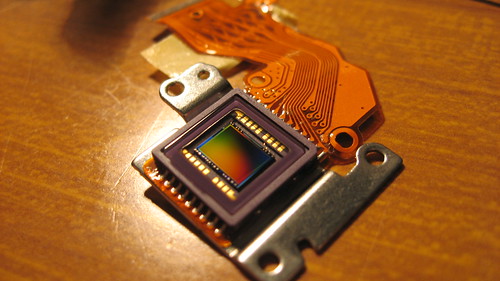A CCD or Charge-Coupled Device is an analog electronic device that used to be used as the image sensor in place of film in an electronic camera or optical devices like microscopes or telescopes - today they've been almost entirely replaced by CMOS image sensors. CCDs are also used in digital and film cameras as parts of some autofocus and light metering systems. A CCD is a rectangular semiconductor chip with a surface built of an array of light-sensitive areas (pixels). Each pixel is a kind of combination of photo diode for light-sensitivity and capacitor for analogue value storage. Several old digital cameras used CCDs as their image sensor, although now practically all use CMOS technology.
The CCD was invented in 1969 at Bell Labs by Willard Boyle and George Smith[1]. Since that CCD was sensitive to light it was used as image sensor for video and TV cameras. It could also be used as a memory device or analogue signal delay since it's principally a kind of analogue shift-register circuit. Thus the image information given in parallel to the whole pixel matrix during exposure is read sequentially by the camera's image processor after exposure.
In 1972 semiconductor maker Fairchild introduced the first experimental CCD for photography which made exposures of the format 100×100 pixels. Production was launched in 1974. In 1986 Kodak introduced the first 1 Megapixel CCD.
As a plain CCD will only produce a greyscale image, further developments were needed for them to see in colour. Some early cameras (e.g. Minolta RD-175) used more than one CCD - with a colour-separation prism or filter directing different colours of light to the individual sensors, analogous to some early colour film photography techniques. The dominating colour separation concept of digital photography's first two decades was developed in 1975 by Kodak's Dr. Bryce Bayer who had the idea of putting a color filter onto each light-sensitive area of the chip. A repeated four pixel pattern with two green-, one blue- and one red-filtered area was the successful design for better colour CCDs. Nowadays even Kodak begins to use alternate filter patterns, but the so-called Bayer filter or Bayer RGGB pattern is still in use by the image sensor makers. Colour filtering does come at the expense of some resolution relative to a plain black and white CCD, as well as losing light sensitivity by aproximately one stop.
Some anomalous CCD designs exist. For example Fujifilm's SuperCCD had a couple of different flavors where the pixel array was rotated 45 degrees and in some cases smaller, less sensitive pixels were added for increased dynamic range, though at the cost of increased noise that was camouflaged with JPG image processing.

|
| 3.2 megapixel CCD device of a Canon PowerShot A75 digital compact camera |
CCD properties[]
The resolution of the image sensor governs the resolution of the camera, although some cameras can produce increased pixel counts using interpolation software - particularly with multi-CCD sensors.
The physical size of the sensor is important in several respects, for example:
- Larger sensors can perform better at lower light levels - this is not because of the size of the image sensor itself, but because the aperture sizes of the lenses used by larger formats are bigger. For example a "normal" 50mm lens at f/2 has a 25mm aperture diameter, while a "normal" 25/2 on a smaller format would only have a 12.5mm diameter aperture capturing only quarter of light. The cost for collecting more light is reduces depth of field.
- The maximum signal an image sensor can capture is larger the bigger the sensor is, thus the image quality will be better with very large exposures.
- Larger sensors have typically more pixels.
- Just like larger film formats, larger sensors require longer focal-length - and in many cases larger - lenses, thus dictating the size (and weight) of the camera. Larger lenses may also increase the cost of the camera. However, it is surprisingly the larger formats which often have smaller lenses when the lens performance curves are similar - this is because a smaller format lens requires a smaller f-number to achieve the same aperture size which leads to more complex lens design.
- It is easy to create a fully electronic global shutter to CCD sensor to allow for very fast flash synch speeds and motion distortion free imaging. This however sacrifices one stop of sensitivity.
CCDs for through-the-lens measuring[]
Through-the-lens measuring techniques, especially distance measuring of autofocus systems rely on CCD components, even in analog SLRs. Light metering can also be based on a CCD as sensor.